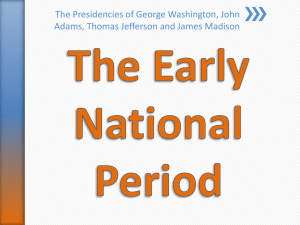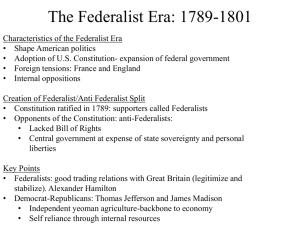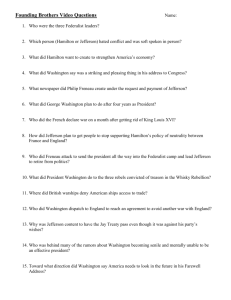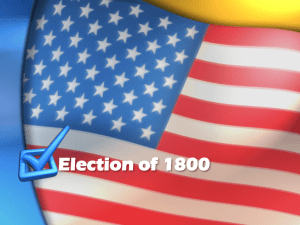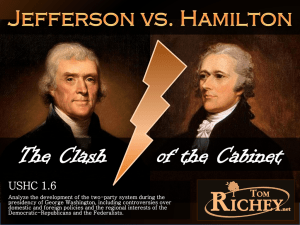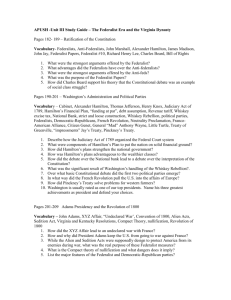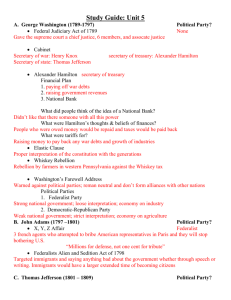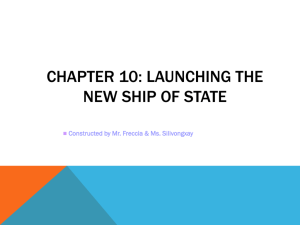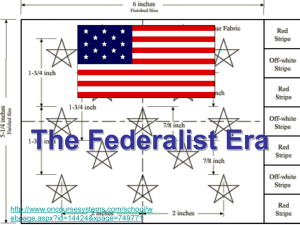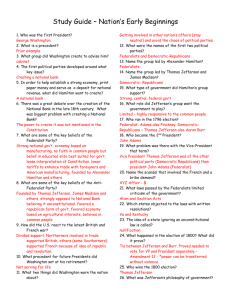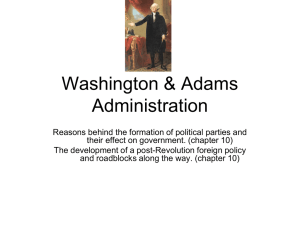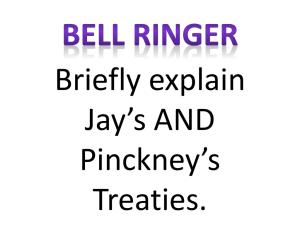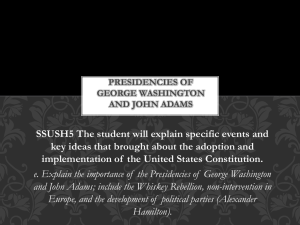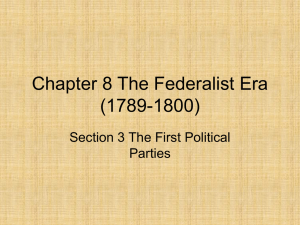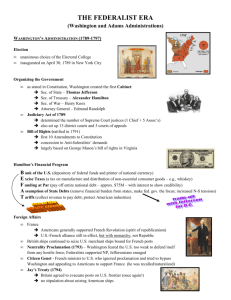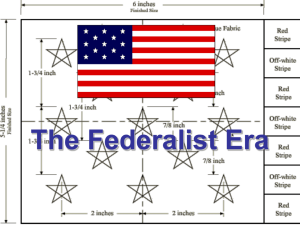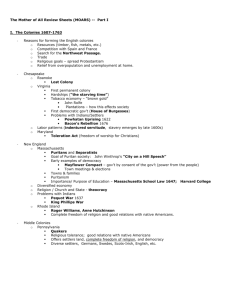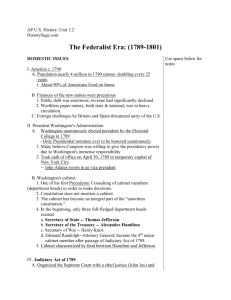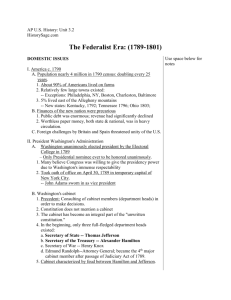THE BEGINNINGS OF POLITICAL PARTIES
advertisement
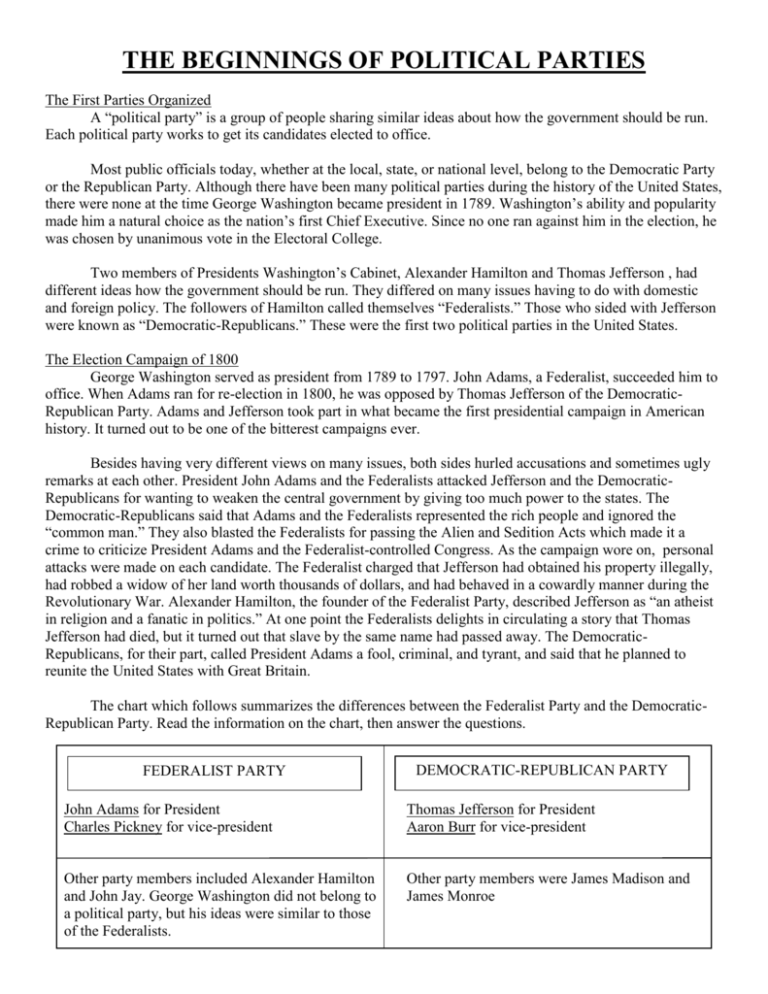
THE BEGINNINGS OF POLITICAL PARTIES The First Parties Organized A “political party” is a group of people sharing similar ideas about how the government should be run. Each political party works to get its candidates elected to office. Most public officials today, whether at the local, state, or national level, belong to the Democratic Party or the Republican Party. Although there have been many political parties during the history of the United States, there were none at the time George Washington became president in 1789. Washington’s ability and popularity made him a natural choice as the nation’s first Chief Executive. Since no one ran against him in the election, he was chosen by unanimous vote in the Electoral College. Two members of Presidents Washington’s Cabinet, Alexander Hamilton and Thomas Jefferson , had different ideas how the government should be run. They differed on many issues having to do with domestic and foreign policy. The followers of Hamilton called themselves “Federalists.” Those who sided with Jefferson were known as “Democratic-Republicans.” These were the first two political parties in the United States. The Election Campaign of 1800 George Washington served as president from 1789 to 1797. John Adams, a Federalist, succeeded him to office. When Adams ran for re-election in 1800, he was opposed by Thomas Jefferson of the DemocraticRepublican Party. Adams and Jefferson took part in what became the first presidential campaign in American history. It turned out to be one of the bitterest campaigns ever. Besides having very different views on many issues, both sides hurled accusations and sometimes ugly remarks at each other. President John Adams and the Federalists attacked Jefferson and the DemocraticRepublicans for wanting to weaken the central government by giving too much power to the states. The Democratic-Republicans said that Adams and the Federalists represented the rich people and ignored the “common man.” They also blasted the Federalists for passing the Alien and Sedition Acts which made it a crime to criticize President Adams and the Federalist-controlled Congress. As the campaign wore on, personal attacks were made on each candidate. The Federalist charged that Jefferson had obtained his property illegally, had robbed a widow of her land worth thousands of dollars, and had behaved in a cowardly manner during the Revolutionary War. Alexander Hamilton, the founder of the Federalist Party, described Jefferson as “an atheist in religion and a fanatic in politics.” At one point the Federalists delights in circulating a story that Thomas Jefferson had died, but it turned out that slave by the same name had passed away. The DemocraticRepublicans, for their part, called President Adams a fool, criminal, and tyrant, and said that he planned to reunite the United States with Great Britain. The chart which follows summarizes the differences between the Federalist Party and the DemocraticRepublican Party. Read the information on the chart, then answer the questions. FEDERALIST PARTY DEMOCRATIC-REPUBLICAN PARTY John Adams for President Charles Pickney for vice-president Thomas Jefferson for President Aaron Burr for vice-president Other party members included Alexander Hamilton and John Jay. George Washington did not belong to a political party, but his ideas were similar to those of the Federalists. Other party members were James Madison and James Monroe FEDERALIST PARTY DEMOCRATIC-REPUBLICAN PARTY Party supporters were the rich and well-born, the old aristocratic families, large landowners, and wealthy businessmen. The party was strong in the New England states. Party supporters were farmers, the poor, small southern plantation owners. The party’s strength was in the southern states. Favored a strong central government and weaker state governments. Favored a weak central government and stronger state governments. Thought the government should be controlled by the rich and well-born because they were better prepared to run the government. Thought the government should be controlled by the “common man.” Supported Hamilton’s financial program which was designed to raise money to run the government and pay off U.S. debts from the Revolutionary War. Money would be raised by: (a.) a tariff, or a tax on foreign goods entering the U.S. (b.) an excise tax on American-made whiskey. Hamilton also organized the Bank of the United States. Opposed Hamilton’s program which they said favored the rich. Sided with the British in the conflict between Great Britain and France. Sided with the French in the conflict between Great Britain and France. Controlled the government from 1789 until 1800, and claimed to have accomplished these things: Differed from the Federalists on there points: (a.) established credit of U.S. by paying off money owed to other countries (b.) created a dependable money system (c.) increased trade and industry (d.) set up a smooth-running government (e.) added the Bill of Rights to the U.S. Constitution (f.) created a system of courts and a postal system (g.) put down the Whiskey Rebellion (h.) admitted 3 new states to the Union: Vermont, Kentucky, and Tennessee (i.) in foreign affairs, followed a policy of peace by signing Jay’s Treaty with Great Britain and the Pickney Treaty with Spain (j.) took a stand against France during the XYZ (a.) considered farming interests to be more important than than business and industry (b.) opposed the Alien and Sedition Acts for taking away individual freedoms and rights, especially the right to criticize the government (c.) attacked Jay’s Treaty with Great Britain for not solving the problem of British impressment of American seamen Affair (k.) earned the respect of foreign nations Abe U.S. History Name:_____________________________________________________Period:_________Date:__________ BEGINNINGS OF POLITICAL PARTIES Directions: After reading the previous two pages, please answer the following questions in complete sentences. 1.) In your own words what is a political party? 2.) Why was the presidential election of 1800 considered an “ugly” election? 3.) a.) What did the Federalists believe in? b.) What did the Democratic-Republicans believe in? 4.) Which party would the following people support? Why? a.) a rich businessman b.) a plantation owner c.) a person who favors less governmental regulation d.) a common farmer e.) a factory worker f.) you 5.) Which current political parties are the Federalist and the Democratic Republican parties most similar to? Who and why?
